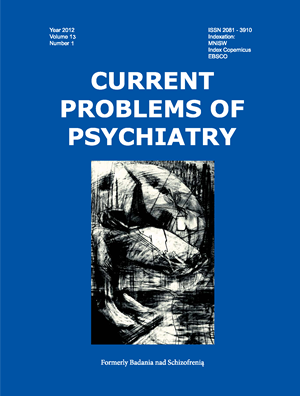Alexithymia in patients with cardiac diseases and patients with mood disorders– preliminary reports
Keywords:
alexithymia, cardiological diseases, depressionAbstract
Aim: The primary objective of this study was to evaluate the intensity of the syndrome and the various dimensions of alexithymia constituted in patients treated for cardiac diseases. The results obtained were compared with a group of patients with known bipolar disorder.
Material and methods: The subjects were patients aged between 18-65 years of age (M = 50,00 years, SD = 10,68), treated for co-ronary heart disease, heart failure, heart rhythm disorders, including post myocardial infarction and hypertension. The control group consisted of 28 patients with mental disorders - mood disorders aged 18-65 years of age (M = 50,43 years, SD = 13,17), 10 women and 18 men. The study used a scale of Bermond-Vorst Alexithymia Questionnaire (BVAQ) containing 40 questions divided into 5 dimensions.
Results: Patients with cardiac diseases compared to people with mood disorders are characterized by lower levels of alexithymia and three of the five dimensions making up the deficit of personality. Statistically significant differences were associated with the level of intensity in the difficulty in verbalizing emotional and poor insight into their own emotional experiences. Taking into account their gender subjects did not differ statistically significantly in terms of the analyzed variables. With increasing age only one of the variables of alexithymia components significantly enhances: poverty of imagination.
Conclusions: Patients with heart disease differ statistically from the control group in terms of two dimensions alexithymia: diffi-culty in verbalizing emotional and poor insight into their own emotional experiences to give lower results for these variables. The pre-sented preliminary analysis of reports of research, and understanding of the relationship between cardiovascular disease and alexithy-mia syndrome requires further analysis.
References
1. Nemiah J.C., Sifneos P.E. Affect and fantasy in patients with psychosomatic disorders. In: Hill OW. ed. Mod. Trends Psychosom. Med., 1970: 26-34.
2. Goleman D. Inteligencja emocjonalna. Poznań; Media Rodzina of Poznań: 1997.
3. Ogłodek E., Marek L., Araszkiewicz A., Placek W., Moś D. Aleksytymia u pacjenta chorującego na łuszczycę i depresję. Przegl. Dermatol., 2009; 96: 363-366.
4. Williams P. Personality and illness behavior. In: Vollrath M. ed., Hnadbook of Personality and Health. Chichester; Wiley: 2006, s. 157-173.
5. Płońska D., Czernikiewicz A. Aleksytymia- ciągle wiele pytań. Część I. Definiowanie aleksytymii. Psychiatria, 2006; 3 (1): 1-7.
6. Płońska D., Hnat L., Grzesiewska J., Czernikiewicz A. Aleksytymia - ciągle wiele pytań. Część II. Aleksytymia w wybranych za-burzeniach psychicznych i somatycznych. Psychiatria, 2006; 3 (1): 8-14.
7. Taylor G.J. The alexithymia construct: conceptualization, validation and relationship with basic dimensions of personality. New Trends Exp. and Clin. Psychiatr., 1994; 10:61-74.
8. Taylor G.J. Alexithymia: 25 years of theory and research. In: Nyklicek I., Temoschok L.R., Vingerhoets A ed., Emotional expression and health. Washington; Brunner-Routledge: 2004, s. 137-153.
9. Ogińska-Bulik N., Juczyński Z. Osobowość, stres a zdrowie. Warszawa, Difin: 2008.
10. Rodin J, Solovey P. Psychologia zdrowia. W: Heszen-Niejodek I., Sęk H. red., Psychologia zdrowia. Warszawa; PWN: 1997, s. 62-110.
11. Schier K. Aleksytymia-mechanizm obronny czy cecha osobowości? Nowe perspektywy badawcze. Psychoterapia, 2006; 1(136): 5-13.
12. Sym A., Gawęda Ł., Wiktorska- Zapała J. Ocena związków poczucia wpływu na przebieg schizofrenii z temperamentem i aleksy-tymią. Psychiatria, 2010; 7 (1): 25-32.
13. Tomalski R. Aleksytymia w zaburzeniach jedzenia. Psychoterapia, 2006; 1 (136): 15-24
14. Tomalski R. Aleksytymia i dysocjacja. Psychoterapia, 2008; 2(145): 35-43.
15. Vorst C.M., Bermond B. Validity and reliability of the Bermond Vorst Alexithymia Questionnaire. Pers. Individ. Dif., 2001; 30: 413-434.
16. Bamonti P.M., Heisel M.J., Topciu R.A., Franus N. Association of alexithymia and depression symptom severity in adults aged 50 years and older. Am. J. Geriatr. Psychiatry, 2010; 18 (1): 51-56.
17. Maruszewski T., Ścigała E. Emocje, aleksytymia, poznanie. Poznań; Wydawnictwo Fundacji Humanior: 1998.
18. Kojima M., Frasure-Smith N., Lesperance F. Alexithymia following myocardial infarction: psychometric properties and corre-lates of the Toronto Alexithymia Scale. J Psychosom Res, 2001; 51: 487–495.
19. Todarello O., Taylor G.J., Parker J.D., Fanelli M. Alexithymia in essential hypertensive and psychiatric outpatients: a comparative study. J. Psychosom. Res., 1995; 39: 987- 94.
20. Kauhanen J., Kaplan G.A., Cohen R.D., Julkunen J., Salonen J.T. Alexithymia and risk of death in middle-aged men. J. Psychosom. Res., 1996; 41: 541–549.
21. Osti R.M., Trombini G., Magnani B. Stress and distress in essential hypertension. Psychother. Psychosom., 1980; 33: 193-197.
22. Lyshova O.V., Provotorov V.M., Chernov I.N. Clinical characteristics of hypertensive disease in patients with alexithymia. Kardiologia, 2002; 42: 47-50.
23. Małyszczak K., Pyszel A., Szuba A. Podskala Kwestionariusza Aleksytymii Bermonda-Vorsta związana z rozpoznaniem nadciśnienia tętniczego. Post. Psychiat. Neurol., 2007; 16 (1): 43-47.
24. Golińska L. Nieświadome emocje – deficyt, obrona czy samooszukiwanie? Nowiny Psychologiczne, 2008; 2: 31-44.
25. Lumley M.A. Alexithymia, emotional disclosure and health. A program of research. Journal of Personality, 2004; 72: 1271-1300.
26. Lumley M.A., Beyer J., Radcliffe A. Alexithymia and physical health problems: A critique of potential pathways and a research agenda. In: Vingerhoets A., Nyklicek I., Denollet J ed., Emotion reulation. Conceptual and clinical issues. New York; Springer: 2008, s. 43-68.


